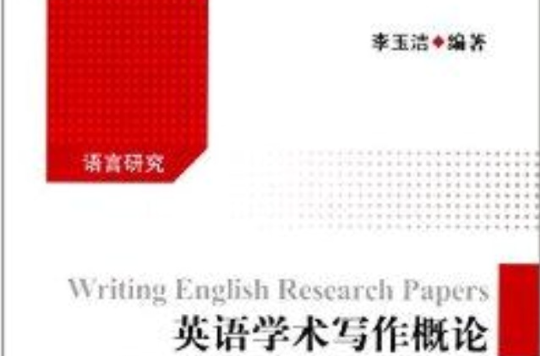《語言研究:英語學術寫作概論》涉及學術論文寫作的主要內容,包括選題、提綱、遣詞造句、銜接與連貫、文獻引用及其標註、以及摘要寫作等。主要針對在校本科生,研究生及廣大在職專業人士在寫作英語論文過程中的實際需要,幫助讀者了解學術論文寫作的要求,和論文構成的主要方面,指導讀者寫出符合學術規範的高質量論文。
基本介紹
- 書名:語言研究:英語學術寫作概論
- 作者:李玉潔
- 出版日期:2013年8月1日
- 語種:簡體中文, 英語
- 品牌:智慧財產權出版社
- 外文名:Writing English Research Papers
- 出版社:智慧財產權出版社
- 頁數:134頁
- 開本:16
內容簡介
圖書目錄
1.1 Characteristics of a research paper
1.2 Types of research papers
1.3 The structure of a research paper
1.3.1 The front matter
1.3.1.1 Title page
1.3.1.2 Outline page
1.3.1.3 Abstract
1.3.2 The body
1.3.2.1 Introduction
1.3.2.2 Literature review
1.3.2.3 Writing the conclusion
1.3.3 The back matter
1.3.3.1 References
1.3.3.2 Appendices
Chapter 2 The Process of Writing a Research Paper
2.1 Choosing a topic
2.2 Exploring sources
2.3 Evaluating resources
2.4 Outlining the paper
2.4.1 Topic outline
2.4.2 Sentence outline
2.5 Writing the first draft
2.6 Revising and editing
2.7 Proofreading
Chapter 3 Literature Review
3.1 Components of literature review
3.2 Mistakes in writing a literature review
3.3 Examples of good literature reviews
Chapter 4 Methodology
4.1 Qualitative approach
4.2 Quantitative approach
4.3 Ways to collect data
4.3.1 Interview
4.3.2 Questionnaire
Chapter 5 Language and Style
5.1 Diction
5.1.1 Avoid colloquialisms
5.1.2 Avoid personalization
5.1.3 Avoid gender limitations
5.1.4 Avoid using the same word repeatedly
5.2 Sentence structure
5.2.1 Parallelism
5.2.1.1 Balanced parallel ideas in a series
5.2.1.2 Balanced parallel ideas presented as pairs
5.2.2 Shifts
5.2.2.1 Make the point of view consistent
5.2.2.2 Make verbs consistent in mood and voice
5.2.2.3 Avoid sudden shifts from indirect to direct questions or quotations
5.2.3 Sentence variety
5.2.3.1 Use a variety of sentence structures
5.2.3.2 Use a variety of sentence openings
5.2.3.3 Try inverting sentences occasionally
Chapter 6 Mechanics
6.1 Abbreviations
6.1.1 Social and professional titles & similar terms
6.1.2 Organizations
6.2 Units of measurement
6.3 Titles of works
6.4 Numbers
6.4.1 Use of words of numerals
6.4.2 Punctuation of numbers
6.4.3 Decimals and percentage
Chapter 7 Abstract
7.1 Reasons of making up an abstract
7.2 Elements of an abstract
7.3 qhe relationships between an abstract text and a research text
7.4 Samples of abstract
Chapter 8 Documentation
8.1 Supporting a thesis
8.1.1 Use sources to inform and support your argument
8.1.1.1 Providing background information or context
8.1.1.2 Explaining terms or concepts
8.1.1.3 Supporting your claims
8.1.1.4 Lending authority to your argument
8.2 Citing sources and avoiding plagiarism
8.2.1 Cite quotation and borrowed ideas
8.2.2 Enclose borrowed language in quotation marks
8.2.3 Put summaries and paraphrases in your own words
8.2.4 Plagiarism: unacceptable borrowing
8.3 Integrating sources
8.3.1 Limit your use of quotations
8.3.1.1 Using the ellipsis mark and brackets
8.3.1.2 Setting off long quotations
8.3.2 Use signal phrases to integrate sources
8.3.2.1 Using signal phrases in MLA papers
8.3.2.2 Marking boundaries
8.3.2.3 Establishing authority
8.3.2.4 Introducing summaries and paraphrases
8.3.2.5 Putting direct quotations in context
8.3.2.6 Integrating statistics and other facts
Chapter 9 Documenting sources: Modern Language Association (MLA) Style
9.1 MLA in—text citations
9.2 Basic rules for print and electronic sources
9.3 Variation on the basic rules
9.4 MLA list of works cited
9.4.1 General guidelines for listing authors
9.4.2 Basic format for a book
9.4.3 Articles in periodicals
9.4.4 Online sources
9.5 Alphabetizing the list
9.5.1 Indenting
9.5.2 Web addresses
Bibliography

